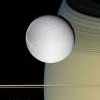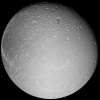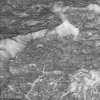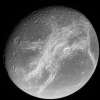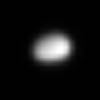Dione orbits Saturn in a near circular orbit with a radius of 377,396 km (miles). It completes one orbit every 2 days, 17 hours and 41 minutes. It is near spherical, with a mean diameter of 1,123 km (~700 miles). It comprises a surface of water ice over a rocky silicate core. Its relatively high density implies the rocky core represents around 46% of the mass; somewhat higher than most of Saturn's moons.
Like many of Saturn's moons, its rotational period is synchronous with its orbit so it has the same face towards Saturn. Most scientists expected the leading hemisphere to be the more heavily cratered, but the opposite turned out to be the case. The generally accepted premise is that Dione was initially tidally locked in the opposite orientation during the period of heavy bombardment, which finished about 3.8 billion years ago. Its low mass means that an impact causing a crater about 35 km (21 miles) in diameter would be enough to spin the moon around. Dione has a great many craters this size and larger, so could have had changes in orientation many times. The pattern of more recent craters implies that Dione has been in its present orientation for several billion years.
Like many of Saturn's moons, its rotational period is synchronous with its orbit so it has the same face towards Saturn. Most scientists expected the leading hemisphere to be the more heavily cratered, but the opposite turned out to be the case. The generally accepted premise is that Dione was initially tidally locked in the opposite orientation during the period of heavy bombardment, which finished about 3.8 billion years ago. Its low mass means that an impact causing a crater about 35 km (21 miles) in diameter would be enough to spin the moon around. Dione has a great many craters this size and larger, so could have had changes in orientation many times. The pattern of more recent craters implies that Dione has been in its present orientation for several billion years.
Dione & Its Trojans
Solar System -
Saturn's Moons
All images Credit: NASA/JPL/Space Science Institute (Cassini)
Saturn's moons are grouped as follows. Select to see details of the moon or the group of moons:
Mimas • Enceladus • Tethys • Dione • Rhea • Titan • Iapetus • Hyperion • Norse Grp • Shepherd Moons • Alkyonides • Inuit Grp • Gallic Grp • Misc
Polydeuces is a tiny moon about 3.5 km (2.2 miles) across that was first observed in 2004. It orbits Saturn in the L5, trailing, Legrangian point of Dione, although it moves considerably from the precise Lagrangian point. Instead of a fixed 60º lag, it varies between 33.9º and 91.4º with a period of nearly 791 days. Its orbital period and mean radius are both close to those of Dione.
Two images of Helene, a small, irregular moon about 43.4×38.2×26 km with an average diameter of 35.2 km. First observed in 1980, it orbits Saturn in the L4, leading, Legrangian point of Dione, 60º ahead of Dione, with the same orbital period and mean radius.
A third image of Helene taken on January 31st 2011 by the Cassini probe. Cassini took the picture from about 31,000 kilometers (19,250 miles) away from Helene.
Cassini's view of Dione with Saturn behind. As the probe is almost in the plane of the rings, they appear as a thin line across Saturn's disk. The coloration is close to how it would appear to the human eye. The images were taken using a wide angle camera from about 39,000 km (24,200 miles) away.
Taken during Cassini's close approach to Dione on October 11, 2005, from a distance of about 4,490 kilometers kilometers (2,787 miles). The resolution is about 23 meters (75 feet) per pixel.
taken on July 24, 2006 from about 263,000 kilometers (163,000 miles) away, this is an image of the the trailing hemisphere of Dione, with north up. The feature at the lower right, with the multiple "rays" extending in all directions, is called Cassandra.
Cassini took this picture of Dione during a close approach in April 2007 from a distance of about 121,000 km (75,000 miles). It gives an excellent view of the craters and deep valleys
Significant variations in the density of impact craters on the surface of Dione can be seen here, with more craters seen on the right side of this mosaic (on Dione's sub-Saturn hemisphere) than on the left (on Dione's anti-Saturn hemisphere). The southern end of the bright Palatine Linea fracture system can be seen near the bottom of the mosaic. Along the terminator, at lower left, part of a large impact basin can be seen.
Significant variations in the density of impact craters on the surface of Dione can be seen here, with more craters seen on the right side of this mosaic (on Dione's sub-Saturn hemisphere) than on the left (on Dione's anti-Saturn hemisphere). The southern end of the bright Palatine Linea fracture system can be seen near the bottom of the mosaic. Along the terminator, at lower left, part of a large impact basin can be seen.
Cassini took this image on October 11, 2005. It is a mosaic of several images taken from distances varying from about 55,280 to 27,180 km (34,350 to 16,890 miles) from Dione.
The colors in the images have been processed to emphasise subtle changes in the surface.
The surface features appear to represent several "generations". The ridges and troughs seen in the upper right, together with the craters in that area, are some of the oldest features of the surface. They are almost certainly older than the bright, wispy markings that can be seen on the left and lower right. Finally, the criss-cross markings in the lower half are probably the youngest features.
The colors in the images have been processed to emphasise subtle changes in the surface.
The surface features appear to represent several "generations". The ridges and troughs seen in the upper right, together with the craters in that area, are some of the oldest features of the surface. They are almost certainly older than the bright, wispy markings that can be seen on the left and lower right. Finally, the criss-cross markings in the lower half are probably the youngest features.
Dione's Trojan Moons



